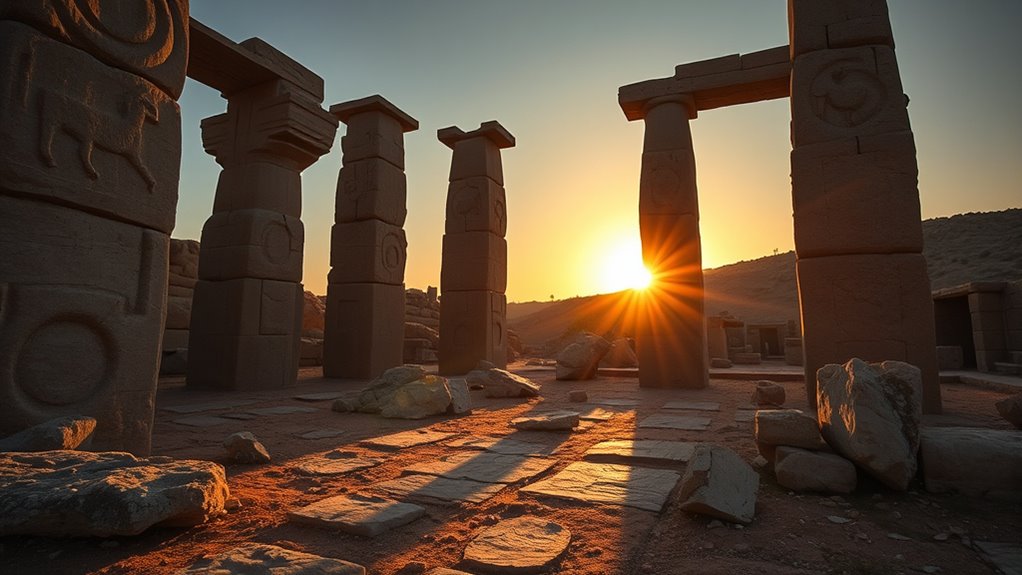Stone-age humans built Göbekli Tepe using primitive tools like flint and hard stones, shaping massive pillars and carvings through skillful manual effort. They worked together in coordinated groups, sharing tasks such as quarrying, moving, and erecting heavy stones without metal tools or machinery. Their social cooperation and ingenuity allowed them to overcome huge logistical challenges, creating a monument that still amazes today. If you’re curious, there’s more to uncover about how they achieved this incredible feat.
Key Takeaways
- They used primitive tools like flint and hard stones for carving and shaping massive limestone pillars.
- Skilled teamwork and social organization enabled coordinated quarrying, transport, and erection of heavy stones.
- They relied on collective effort, communication, and shared knowledge to overcome logistical challenges.
- Rituals and cultural motivations fostered unity, purpose, and motivation among workers.
- Human ingenuity, advanced stone tool mastery, and social cohesion allowed construction without metal tools or machinery.

Who built Göbekli Tepe, and how did they manage to create such an extraordinary site thousands of years ago? You might wonder how people from the Stone Age, with primitive tools and limited resources, could construct something so complex and monumental. The answer lies in their skill with stone tools and their ability to organize socially in ways that modern societies might find hard to imagine. These early humans didn’t have metal tools or advanced machinery, yet they crafted massive stone pillars and intricate carvings that still leave experts in awe. Their success depended heavily on their mastery of stone tools, which they used for carving, shaping, and transporting heavy stones across the rugged landscape. By sharpening flint and other hard stones, they created tools suitable for cutting, scraping, and chipping away at the limestone to produce the pillars and sculptures that define Göbekli Tepe.
But tools alone wouldn’t have been enough. The construction of Göbekli Tepe required a remarkable level of social organization. You need to understand that these early humans worked collectively, pooling their skills and resources to achieve a common goal. Evidence suggests they operated in coordinated groups, assigning roles for quarrying, shaping, and erecting the stones. This social structure likely involved leaders or organizers who coordinated efforts and maintained the site’s development over many years. Such teamwork indicates a complex social fabric, where individuals recognized shared religious or cultural motivations that motivated them to collaborate. These communal efforts weren’t just about survival; they reflected a profound sense of purpose, possibly tied to spiritual beliefs or social cohesion.
The construction process also highlights how their social organization extended beyond mere cooperation. It’s probable that these early humans developed rituals or ceremonies to mark milestones in the building process, fostering a sense of unity and shared identity. The effort needed to transport and erect stones weighing several tons would have been extraordinary, especially without animals or machinery. You’re left to marvel at their ingenuity and collective spirit, which drove them to overcome huge logistical challenges. They relied heavily on their social bonds, communication, and knowledge passed down through generations to complete this monumental project.
In essence, Göbekli Tepe stands as a tribute to what Stone Age humans could achieve through clever use of stone tools and a sophisticated social organization. Their ability to coordinate, share knowledge, and work toward a common purpose led to the creation of a site that continues to fascinate us today. It’s proof that even with simple tools and limited technology, human ingenuity and social cohesion can produce extraordinary results.
Frequently Asked Questions
What Tools Did Ancient Builders Use at Göbekli Tepe?
You’re curious about the tools used by ancient builders. They relied on stone tools like flint blades and chisels for shaping and carving the limestone pillars. Quarrying techniques involved pounding and scraping the rock, likely using hammerstones and percussive tools. These methods allowed them to extract and shape massive stones with impressive precision, demonstrating their skill and resourcefulness despite limited technology.
How Long Did It Take to Construct Göbekli Tepe?
Ah, the timeless curiosity about how long it took to build something monumental! Without knowing the construction timeline or workforce organization, you might imagine it as an effortless feat. In reality, it likely spanned centuries, requiring a highly organized workforce and meticulous planning. Stone-age humans probably labored for generations, steadily transforming massive stone pillars into a sacred site—proof that patience and cooperation are ancient virtues.
Were There Any Signs of Advanced Planning Before Construction?
You might wonder if there was advanced planning involved. Evidence suggests prehistoric cognition and ceremonial foresight played roles in their construction. The deliberate placement of stones and complex layout indicate they planned the site’s design beforehand. This shows that stone-age humans didn’t just react to immediate needs—they envisioned a purpose, organizing resources and labor meticulously to create this ceremonial space, reflecting sophisticated thinking and foresight.
How Did They Transport the Massive Stone Pillars?
Ever wonder how primitive transportation of massive stones was possible? You might think it required advanced tools, but it was really about clever labor organization and teamwork. Stone-age humans likely used logs as rollers, ropes for leverage, and coordinated effort to move the pillars. Their ingenuity shows that even with primitive technology, they could achieve incredible feats through planning and collective effort. Does this challenge your ideas about early human capabilities?
What Was the Purpose of Göbekli Tepe’s Intricate Carvings?
You see, the intricate carvings at Göbekli Tepe serve as symbolic art that likely holds ritual significance. These detailed engravings probably depict animals, deities, or spiritual symbols, helping early humans connect with their beliefs or environment. Their purpose wasn’t just decoration but to reinforce spiritual practices, communicate stories, or invoke protection. So, these carvings were a essential part of the site’s ceremonial and cultural functions.
Conclusion
As you reflect on Göbekli Tepe’s builders, remember they were like modern explorers venturing into the unknown, shaping history with their ingenuity. Their mastery over stone echoes the mythic craftsmen of legend, proving that even in the dawn of time, humans possessed an extraordinary drive to create and understand. Just as the ancient stones endure, so does your curiosity—reminding you that the spirit of discovery is timeless, forever echoing through human history.









